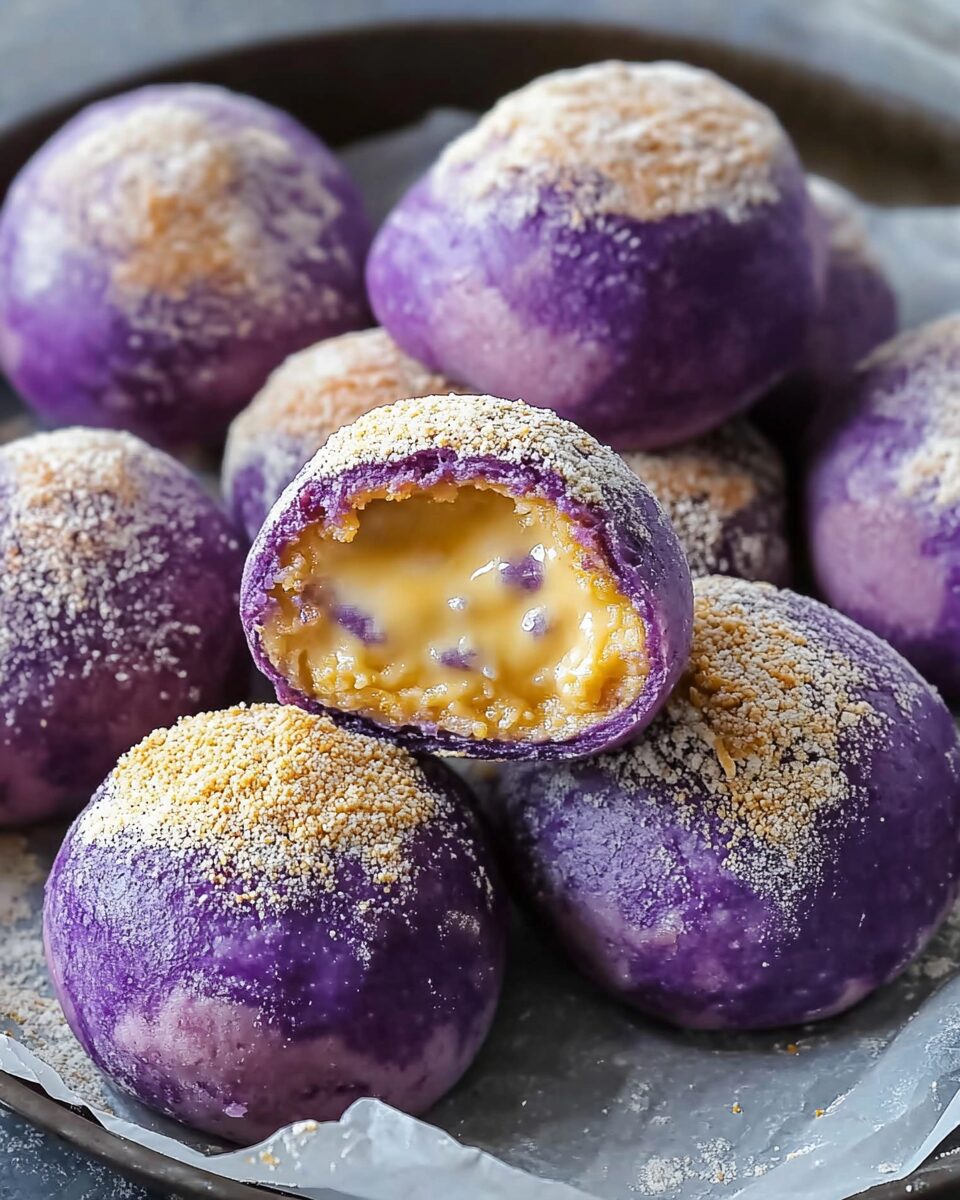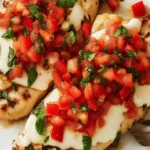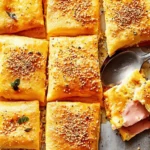Ube Pandesal with Cheese is a delicious twist on the classic Filipino bread roll. The soft, slightly sweet pandesal dough is infused with the vibrant flavor of ube, a purple yam that adds a unique taste and color. Inside, a gooey cheese filling complements the soft bread for a delightful treat, perfect for breakfast or as a snack.
FULL RECIPE
Ingredients
- 2 ½ cups all-purpose flour
- 1 cup mashed ube (cooked or ube halaya)
- 2 tbsp sugar
- 1 tsp salt
- 1 tbsp instant yeast
- ½ cup warm milk
- ¼ cup butter, melted
- 1 egg
- ½ cup bread crumbs (for coating)
- 1 cup grated cheese (such as cheddar or queso de bola)
- 1 tbsp vegetable oil (for greasing)
Directions
- In a mixing bowl, combine flour, sugar, salt, and yeast. Stir to mix.
- Add the mashed ube, warm milk, melted butter, and egg. Mix until the dough starts to form.
- Knead the dough on a lightly floured surface for 8-10 minutes, until smooth and elastic.
- Place the dough in an oiled bowl and cover with a clean towel. Let it rise for 1-1.5 hours or until doubled in size.
- Punch down the dough and divide it into small portions, shaping each into a ball.
- Flatten each ball of dough and place a spoonful of grated cheese in the center. Pinch the edges to seal.
- Roll each filled dough ball in bread crumbs, then place them on a baking sheet lined with parchment paper.
- Preheat the oven to 350°F (175°C). Allow the dough balls to rise for another 30 minutes.
- Bake the ube pandesal for 15-20 minutes or until golden brown.
- Let the pandesal cool slightly before serving.
Nutritional Information
- Calories: 180 per serving
- Protein: 6g
- Carbohydrates: 22g
- Fat: 8g
- Fiber: 1g
History of Ube Pandesal
Ube Pandesal has its roots in the Philippines, where pandesal, a staple Filipino bread, has been enjoyed for generations. The addition of ube, a purple yam known for its distinct flavor and vibrant color, brought a modern twist to the traditional recipe. Ube has long been used in Filipino desserts, and its incorporation into pandesal highlights the Filipino culture’s adaptability and creativity in the kitchen.
The Appeal of Ube in Filipino Cuisine
Ube is a beloved ingredient in Filipino cooking. Its naturally sweet flavor and striking color make it perfect for a wide range of dishes. In desserts like ube halaya, ube ice cream, and ube cakes, it has become synonymous with indulgence and celebration. The growing popularity of ube worldwide has made it a symbol of Filipino culinary innovation, making ube-based dishes, such as Ube Pandesal, increasingly popular even outside the Philippines.
How Ube Pandesal Became a Trend
Over the years, Ube Pandesal has evolved from a local favorite to a trendy snack, not just in the Philippines but in Filipino communities worldwide. The unique combination of soft, fluffy bread with a rich, purple filling has drawn attention for its visually appealing presentation and delicious taste. This bread has become a sought-after item in Filipino bakeries and has also inspired countless variations, such as ube pandesal with cheese, which adds a savory element to the sweet ube filling.
Why Cheese Pairs Well with Ube Pandesal
The addition of cheese to Ube Pandesal elevates the flavor profile by balancing the sweetness of the ube. The creamy, slightly salty cheese contrasts with the smooth and mildly sweet ube, creating a harmonious combination that excites the palate. Filipino cuisine often combines sweet and savory flavors, and the pairing of cheese with ube is a perfect example of this fusion.
Choosing the Right Cheese for Ube Pandesal
When making Ube Pandesal with cheese, the type of cheese you choose can make a significant difference. While traditional recipes call for local cheeses like queso de bola or cheddar, there are many options available depending on personal preference. A sharp cheese like cheddar can provide a more pronounced contrast to the sweetness of the ube, while a milder cheese like mozzarella will offer a creamier, less intense flavor.
The Importance of the Dough’s Consistency
Achieving the right dough consistency is crucial for making Ube Pandesal. The dough should be soft and smooth, without being too sticky. A well-kneaded dough results in a light, fluffy texture that is a signature of good pandesal. The ube mixture adds moisture to the dough, so it’s important to balance the flour and other ingredients to avoid a dough that is too wet or too dry.
Mastering the Rising Process
The rising or proofing stage is key to the perfect Ube Pandesal. Allowing the dough to rise gives the bread its light and airy texture. During this time, the yeast ferments the dough, creating bubbles that cause it to expand. Skipping this process or rushing it can lead to denser bread. Be patient and ensure that the dough doubles in size for the ideal result.
Achieving the Perfect Bread Crumbs Coating
The bread crumbs coating on Ube Pandesal not only adds texture but also helps achieve a golden, crisp exterior. This coating is traditionally made with soft bread crumbs that give the bread its signature crunch. Ensuring that the dough is fully covered in crumbs before baking helps lock in moisture, keeping the inside of the pandesal soft and tender.
Baking Techniques for Ube Pandesal
The baking process is critical to getting the right color and texture for Ube Pandesal. It’s important to preheat your oven so that the bread can bake evenly from the start. Baking at the right temperature ensures that the bread achieves the perfect golden brown color and a soft, fluffy interior. Overbaking can dry out the bread, so it’s important to monitor the pandesal carefully to avoid this.
The Role of Ube in the Color and Texture
The ube in Ube Pandesal contributes not only to the flavor but also to the bread’s beautiful color. The natural purple hue from the ube gives the bread a striking, eye-catching appearance that differentiates it from regular pandesal. Additionally, the ube’s creamy texture enhances the overall mouthfeel of the bread, making each bite a unique experience.
The Versatility of Ube Pandesal
Ube Pandesal is a versatile dish that can be enjoyed in many ways. It can be served as a breakfast item, a snack, or even a dessert. Because of its sweetness and savory cheese filling, it can be paired with coffee, tea, or fresh fruit. Its adaptability makes it a perfect addition to any meal or occasion, whether it’s a casual snack or a festive celebration.
Perfecting Ube Pandesal for Special Occasions
Ube Pandesal is perfect for special occasions, whether it’s a birthday, a family gathering, or a holiday. The vibrant color and unique flavor make it an impressive treat to serve guests. For Filipino celebrations such as Christmas or New Year’s, this variation of pandesal offers a delicious alternative to traditional breads and pastries.
Health Benefits of Ube
Ube is not only delicious but also nutritious. It is a good source of antioxidants, fiber, and vitamins, including vitamin C and vitamin A. While Ube Pandesal is still a bread and should be enjoyed in moderation, the inclusion of ube adds some health benefits compared to other traditional breads made with just flour and sugar.
Adapting Ube Pandesal for Dietary Restrictions
For those with dietary restrictions, Ube Pandesal can be adapted to meet different needs. Gluten-free versions can be made using gluten-free flour, while vegan alternatives can substitute dairy and egg ingredients. These variations allow people with different dietary needs to enjoy this delicious treat without sacrificing flavor or texture.
The Significance of Ube in Filipino Culture
In Filipino culture, ube is more than just an ingredient—it’s a symbol of heritage and tradition. Ube has been part of Filipino cooking for generations and is often used in special family recipes passed down through the years. The inclusion of ube in everyday foods like pandesal reflects how Filipino cuisine blends innovation with tradition, creating a unique culinary identity.
How to Store Ube Pandesal
Ube Pandesal is best enjoyed fresh out of the oven, but if you have leftovers, proper storage is important to maintain its texture and flavor. Store the pandesal in an airtight container or a resealable plastic bag at room temperature for up to two days. For longer storage, freeze the bread and reheat it in the oven or microwave when ready to serve.
Serving Suggestions for Ube Pandesal
Ube Pandesal can be served on its own or paired with various accompaniments. Try it with a dollop of butter, a drizzle of honey, or a smear of jam for added flavor. For a more savory touch, it can be served alongside a fresh salad or a bowl of soup. The possibilities are endless, making it a versatile treat for any time of the day.
Ube Pandesal as a Gift Idea
Ube Pandesal makes a thoughtful and unique gift, especially for those who enjoy trying new flavors. You can bake a batch of Ube Pandesal and package it in a decorative box or tin for a beautiful presentation. This is a perfect way to share a taste of Filipino culture with friends and family, particularly during holidays or special occasions.
Tips for Making Ube Pandesal at Home
Making Ube Pandesal at home can be a fun and rewarding experience. To achieve the best results, use high-quality ube and take your time during each step, especially when kneading the dough and letting it rise. Don’t rush the process, as patience is key to making soft, fluffy pandesal with the perfect balance of sweetness and flavor.
The Popularity of Ube Pandesal Beyond the Philippines
As Filipino cuisine becomes more globally recognized, Ube Pandesal has found a fanbase outside of the Philippines. In places with large Filipino communities, this bread is often a sought-after item in local bakeries. The growing appreciation for Filipino flavors worldwide has made Ube Pandesal a trendy and exciting dish for people of all backgrounds to enjoy.
Conclusion
Ube Pandesal with cheese is a delightful fusion of traditional Filipino bread and modern flavors. The combination of soft, fluffy bread, sweet ube, and savory cheese makes it a unique and irresistible treat. Whether served as a snack, breakfast, or dessert, Ube Pandesal brings the vibrant flavors of Filipino cuisine to the forefront. With its versatility, rich history, and delicious taste, Ube Pandesal is a must-try for anyone looking to explore the world of Filipino baking.






